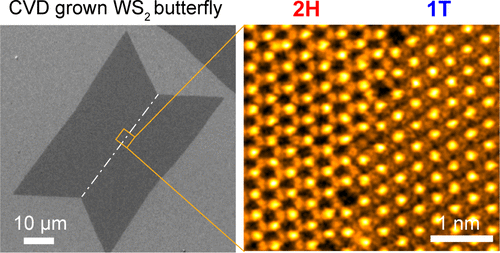Our official English website, www.x-mol.net, welcomes your
feedback! (Note: you will need to create a separate account there.)
Stable 1T Tungsten Disulfide Monolayer and Its Junctions: Growth and Atomic Structures
ACS Nano ( IF 15.8 ) Pub Date : 2018-12-07 00:00:00 , DOI: 10.1021/acsnano.8b04979 Yung-Chang Lin,Chao-Hui Yeh,Ho-Chun Lin,Ming-Deng Siao,Zheng Liu,Hideaki Nakajima,Toshiya Okazaki,Mei-Yin Chou,Kazu Suenaga,Po-Wen Chiu
ACS Nano ( IF 15.8 ) Pub Date : 2018-12-07 00:00:00 , DOI: 10.1021/acsnano.8b04979 Yung-Chang Lin,Chao-Hui Yeh,Ho-Chun Lin,Ming-Deng Siao,Zheng Liu,Hideaki Nakajima,Toshiya Okazaki,Mei-Yin Chou,Kazu Suenaga,Po-Wen Chiu

|
Transition-metal dichalcogenides in the 1T phase have been a subject of increasing interest, which is partly due to their fascinating physical properties and partly to their potential applications in the next generation of electronic devices, including supercapacitors, electrocatalytic hydrogen evolution, and phase-transition memories. The primary method for obtaining 1T WS2 or MoS2 has been using ion intercalation in combination with solution-based exfoliation. The resulting flakes are small in size and tend to aggregate upon deposition, forming an intercalant–TMD complex with small 1T and 1T′ patches embedded in the 2H matrix. Existing growth methods have, however, produced WS2 or MoS2 solely in the 2H phase. Here, we have refined the growth approach to obtain monolayer 1T WS2 up to 80 μm in size based on chemical vapor deposition. With the aid of synergistic catalysts (iron oxide and sodium chloride), 1T WS2 can nucleate in the infant stage of the growth, forming special butterfly-like single crystals with the 1T phase in one wing and the 2H phase in the other. Distinctive types of phase boundaries are discovered at the 1T–2H interface. The 1T structure thus grown is thermodynamically stable over time and even persists at a high temperature above 800 °C, allowing for a stepwise edge epitaxy of lateral 1T heterostructures. Atomic images show that the 1T WS2–MoS2 heterojunction features a coherent and defectless interface with a sharp atomic transition. The stable 1T phase represents a missing piece of the puzzle in the research of atomic thin van der Waals crystals, and our growth approach provides an accessible way of filling this gap.
中文翻译:

稳定的1T二硫化钨单层及其结:生长和原子结构
1T相中的过渡金属二氢硫化物引起了越来越多的关注,这部分是由于其令人着迷的物理特性,部分是由于其在下一代电子设备(包括超级电容器,电催化氢析出和相变)中的潜在应用回忆。获得1T WS 2或MoS 2的主要方法是结合使用离子嵌入技术和基于溶液的剥离技术。生成的薄片尺寸很小,在沉积时易于聚集,形成嵌入了2H基质的1T和1T'小块的Intercalant-TMD复合物。但是,现有的生长方法已经产生了WS 2或MoS 2仅在2H阶段。在这里,我们改进了生长方法,以基于化学气相沉积获得尺寸最大为80μm的单层1T WS 2。借助增效催化剂(氧化铁和氯化钠),1T WS 2可以在生长的婴儿阶段成核,形成特殊的蝴蝶状单晶,其中一个翼在1T相,另一翼在2H相。在1T–2H界面发现了明显的相界类型。如此生长的1T结构在时间上是热力学稳定的,甚至可以在800°C以上的高温下持续存在,从而允许横向1T异质结构的逐步边缘外延。原子图像显示1T WS 2 –MoS 2异质结具有连贯且无缺陷的界面,具有尖锐的原子跃迁。稳定的1T相代表了原子薄范德华晶体研究中缺少的难题,而我们的生长方法为填补这一空白提供了一种可行的方法。
更新日期:2018-12-07
中文翻译:

稳定的1T二硫化钨单层及其结:生长和原子结构
1T相中的过渡金属二氢硫化物引起了越来越多的关注,这部分是由于其令人着迷的物理特性,部分是由于其在下一代电子设备(包括超级电容器,电催化氢析出和相变)中的潜在应用回忆。获得1T WS 2或MoS 2的主要方法是结合使用离子嵌入技术和基于溶液的剥离技术。生成的薄片尺寸很小,在沉积时易于聚集,形成嵌入了2H基质的1T和1T'小块的Intercalant-TMD复合物。但是,现有的生长方法已经产生了WS 2或MoS 2仅在2H阶段。在这里,我们改进了生长方法,以基于化学气相沉积获得尺寸最大为80μm的单层1T WS 2。借助增效催化剂(氧化铁和氯化钠),1T WS 2可以在生长的婴儿阶段成核,形成特殊的蝴蝶状单晶,其中一个翼在1T相,另一翼在2H相。在1T–2H界面发现了明显的相界类型。如此生长的1T结构在时间上是热力学稳定的,甚至可以在800°C以上的高温下持续存在,从而允许横向1T异质结构的逐步边缘外延。原子图像显示1T WS 2 –MoS 2异质结具有连贯且无缺陷的界面,具有尖锐的原子跃迁。稳定的1T相代表了原子薄范德华晶体研究中缺少的难题,而我们的生长方法为填补这一空白提供了一种可行的方法。











































 京公网安备 11010802027423号
京公网安备 11010802027423号